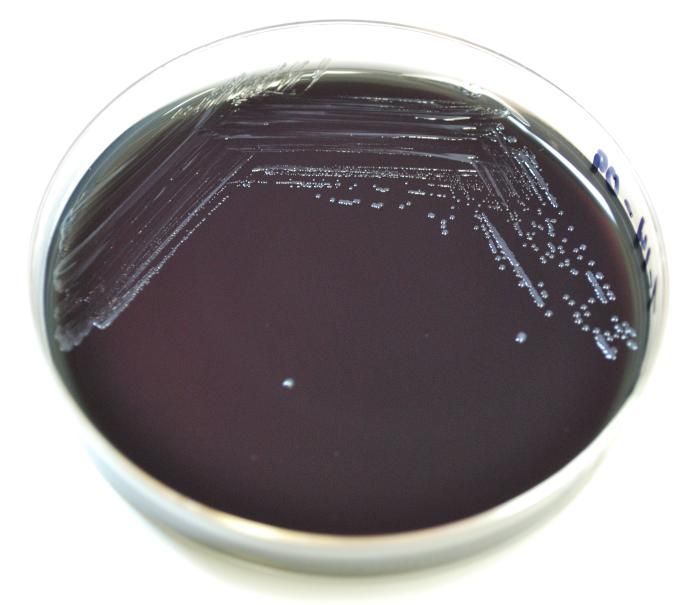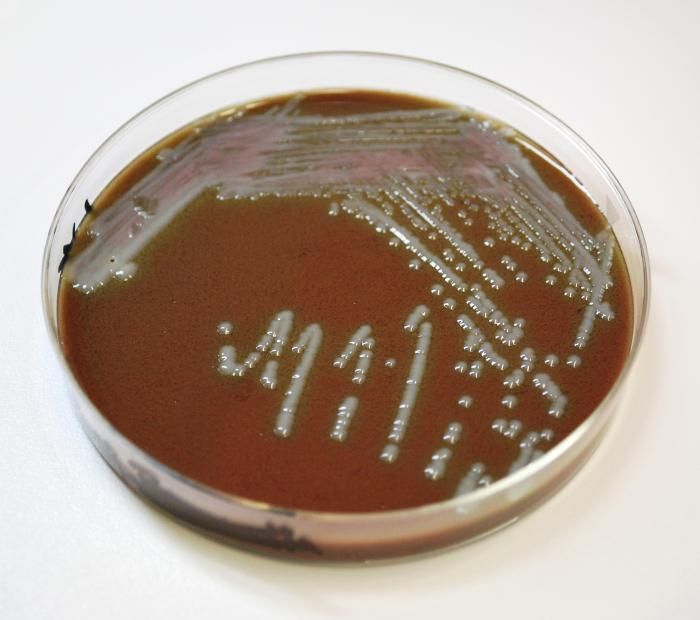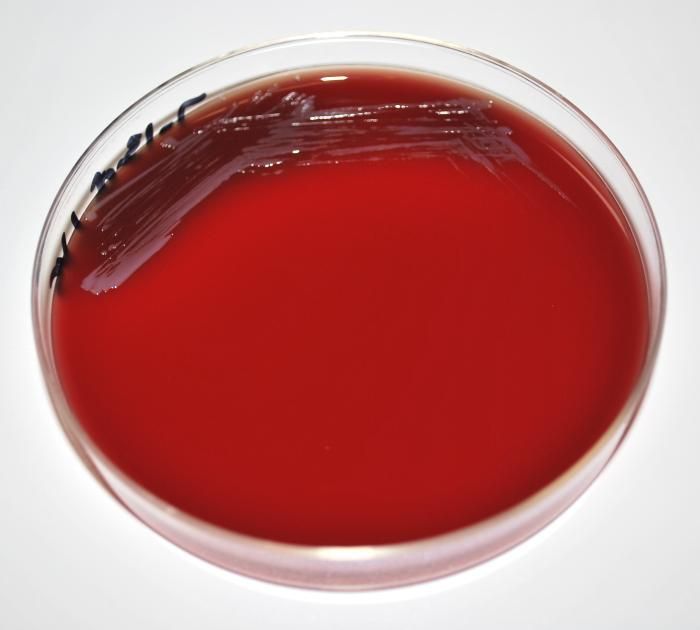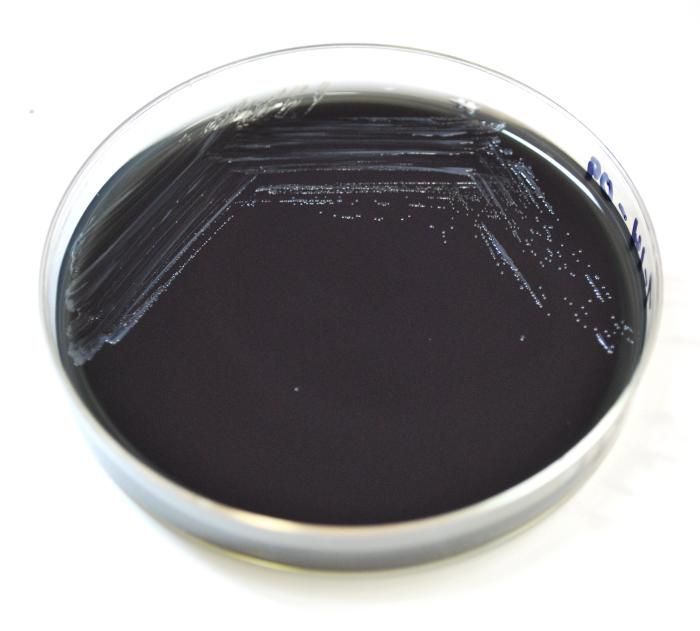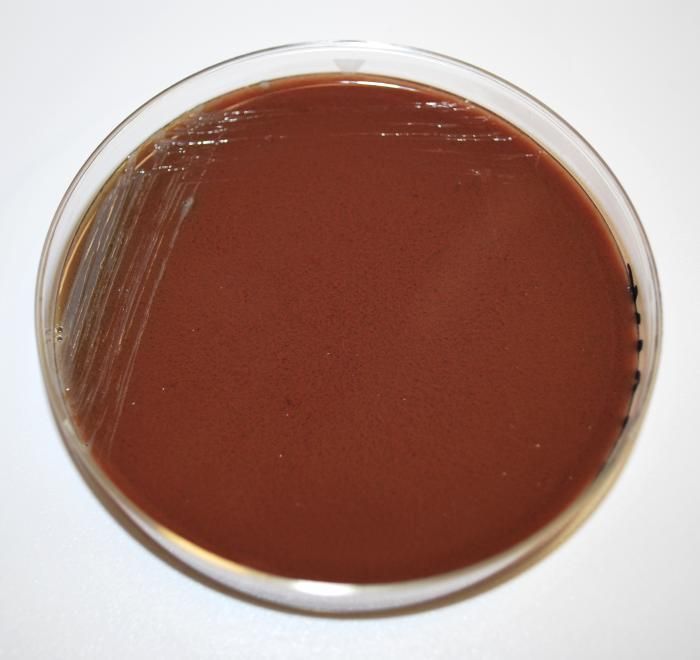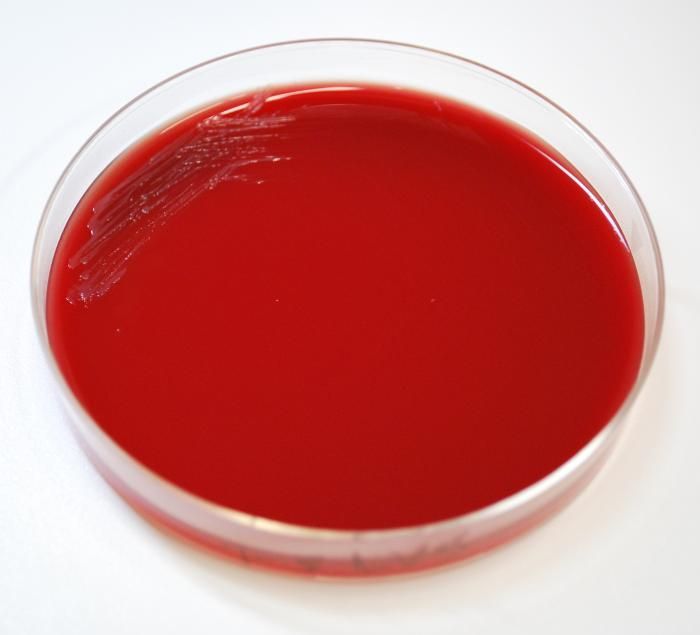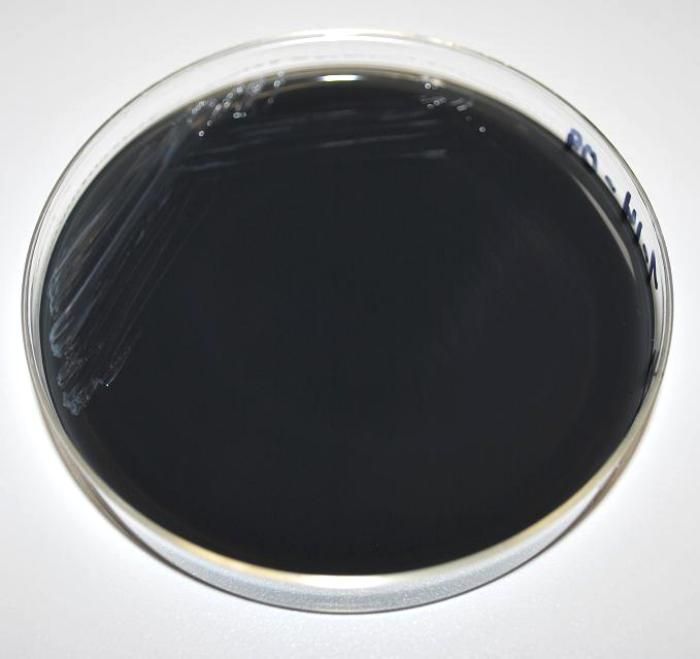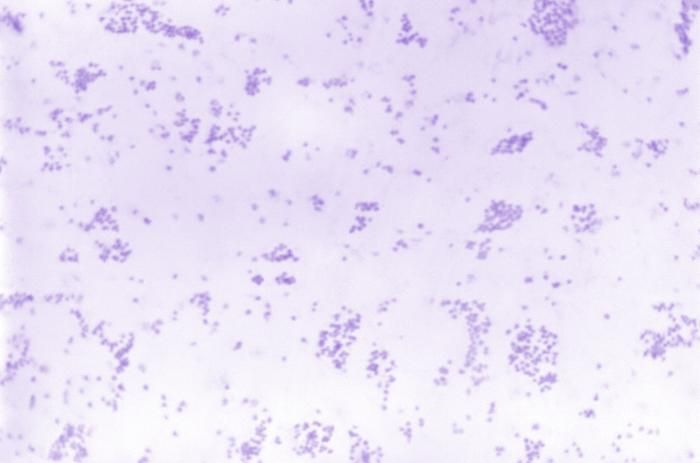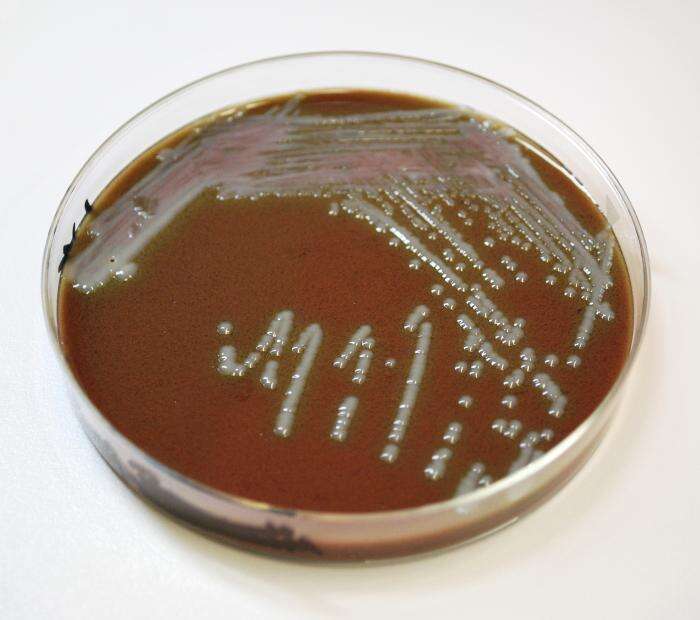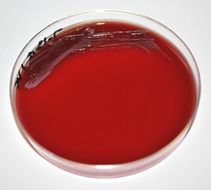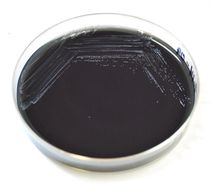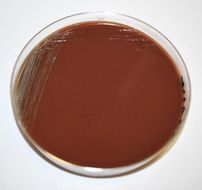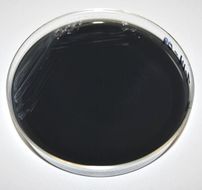-
This image depicts a Petri dish containing a buffered charcoal yeast extract (BCYE) agar medium, which had been inoculated with Gram-negative Francisella tularensis live vaccine strain (LVS) bacteria. F. tularensis is the pathogen responsible for causing the disease tularemia. This was the appearance of the colonial growth after 72 hours of incubation. What is tularemia?Tularemia, also known as rabbit fever, is a disease caused by the bacterium Francisella tularensis. Tularemia is typically found in animals, especially rodents, rabbits, and hares. Tularemia is usually a rural disease and has been reported in all U.S. states except Hawaii.How do people become infected with tularemia?Typically, people become infected through the bite of infected insects (most commonly, ticks and deerflies), by handling infected sick or dead animals, by eating or drinking contaminated food or water, or by inhaling airborne bacteria.Created: 2009
-
This image depicts a Petri dish containing a chocolate agar medium, which had been inoculated with Gram-negative Francisella tularensis live vaccine strain (LVS) bacteria. F. tularensis is the pathogen responsible for causing the disease tularemia. This was the appearance of the colonial growth after 72 hours of incubation. What is tularemia?Tularemia, also known as rabbit fever, is a disease caused by the bacterium Francisella tularensis. Tularemia is typically found in animals, especially rodents, rabbits, and hares. Tularemia is usually a rural disease and has been reported in all U.S. states except Hawaii.How do people become infected with tularemia?Typically, people become infected through the bite of infected insects (most commonly, ticks and deerflies), by handling infected sick or dead animals, by eating or drinking contaminated food or water, or by inhaling airborne bacteria.Created: 2009
-
This image depicts a Petri dish containing a sheeps blood agar (SBA) medium, which had been inoculated with Gram-negative Francisella tularensis live vaccine strain (LVS) bacteria. F. tularensis is the pathogen responsible for causing the disease tularemia. This was the appearance of the colonial growth after 48 hours of incubation. What is tularemia?Tularemia, also known as rabbit fever, is a disease caused by the bacterium Francisella tularensis. Tularemia is typically found in animals, especially rodents, rabbits, and hares. Tularemia is usually a rural disease and has been reported in all U.S. states except Hawaii.How do people become infected with tularemia?Typically, people become infected through the bite of infected insects (most commonly, ticks and deerflies), by handling infected sick or dead animals, by eating or drinking contaminated food or water, or by inhaling airborne bacteria.Created: 2009
-
This image depicts a Petri dish containing a chocolate agar medium, which had been inoculated with Gram-negative Francisella tularensis live vaccine strain (LVS) bacteria. F. tularensis is the pathogen responsible for causing the disease tularemia. This was the appearance of the colonial growth after 48 hours of incubation. What is tularemia?Tularemia, also known as rabbit fever, is a disease caused by the bacterium Francisella tularensis. Tularemia is typically found in animals, especially rodents, rabbits, and hares. Tularemia is usually a rural disease and has been reported in all U.S. states except Hawaii.How do people become infected with tularemia?Typically, people become infected through the bite of infected insects (most commonly, ticks and deerflies), by handling infected sick or dead animals, by eating or drinking contaminated food or water, or by inhaling airborne bacteria.Created: 2009
-
This image depicts a Petri dish containing a buffered charcoal yeast extract (BCYE) agar medium, which had been inoculated with Gram-negative Francisella tularensis live vaccine strain (LVS) bacteria. F. tularensis is the pathogen responsible for causing the disease tularemia. This was the appearance of the colonial growth after 48 hours of incubation. What is tularemia?Tularemia, also known as rabbit fever, is a disease caused by the bacterium Francisella tularensis. Tularemia is typically found in animals, especially rodents, rabbits, and hares. Tularemia is usually a rural disease and has been reported in all U.S. states except Hawaii.How do people become infected with tularemia?Typically, people become infected through the bite of infected insects (most commonly, ticks and deerflies), by handling infected sick or dead animals, by eating or drinking contaminated food or water, or by inhaling airborne bacteria.Created: 2009
-
This image depicts a Petri dish containing a chocolate agar medium, which had been inoculated with Gram-negative Francisella tularensis live vaccine strain (LVS) bacteria. F. tularensis is the pathogen responsible for causing the disease tularemia. This was the appearance of the colonial growth after 24 hours of incubation. What is tularemia?Tularemia, also known as rabbit fever, is a disease caused by the bacterium Francisella tularensis. Tularemia is typically found in animals, especially rodents, rabbits, and hares. Tularemia is usually a rural disease and has been reported in all U.S. states except Hawaii.How do people become infected with tularemia?Typically, people become infected through the bite of infected insects (most commonly, ticks and deerflies), by handling infected sick or dead animals, by eating or drinking contaminated food or water, or by inhaling airborne bacteria.Created: 2009
-
This image depicts a Petri dish containing a sheeps blood agar (SBA) medium, which had been inoculated with Gram-negative Francisella tularensis live vaccine strain (LVS) bacteria. F. tularensis is the pathogen responsible for causing the disease tularemia. This was the appearance of the colonial growth after 24 hours of incubation. What is tularemia?Tularemia, also known as rabbit fever, is a disease caused by the bacterium Francisella tularensis. Tularemia is typically found in animals, especially rodents, rabbits, and hares. Tularemia is usually a rural disease and has been reported in all U.S. states except Hawaii.How do people become infected with tularemia?Typically, people become infected through the bite of infected insects (most commonly, ticks and deerflies), by handling infected sick or dead animals, by eating or drinking contaminated food or water, or by inhaling airborne bacteria.Created: 2009
-
This image depicts a Petri dish containing a buffered charcoal yeast extract (BCYE) agar medium, which had been inoculated with Gram-negative Francisella tularensis live vaccine strain (LVS) bacteria. F. tularensis is the pathogen responsible for causing the disease tularemia. This was the appearance of the colonial growth after 24 hours of incubation. What is tularemia?Tularemia, also known as rabbit fever, is a disease caused by the bacterium Francisella tularensis. Tularemia is typically found in animals, especially rodents, rabbits, and hares. Tularemia is usually a rural disease, and has been reported in all U.S. states except Hawaii.How do people become infected with tularemia?Typically, people become infected through the bite of infected insects (most commonly, ticks and deerflies), by handling infected sick or dead animals, by eating or drinking contaminated food or water, or by inhaling airborne bacteria.Created: 2009
-
Using methylene blue stain, this photomicrograph revealed the presence of Francisella tularensis bacteria, formerly known as Pasteurella tularensis. F. tularensis is the pathogen responsible for causing the disease tularemia.What is Tularemia?Tularemia is a potentially serious illness that occurs naturally in the United States. It is caused by the bacterium Francisella tularensis found in animals (especially rodents, rabbits, and hares).What are the Symptoms of Tularemia?Symptoms of tularemia could include: - sudden fever- chills - headaches- diarrhea - muscle - aches - joint pain - dry cough - progressive weaknessPeople can also catch pneumonia and develop chest pain, bloody sputum and can have trouble breathing and even sometimes stop breathing.Created: 1972
-
Deposition authors: Minasov, G., Shuvalova, L., Dubrovska, I., Winsor, J., Scott, P., Anderson, W.F., Center for Structural Genomics of Infectious Diseases (CSGID);
Wikimedia Commons
Description: English: D-ribulose-5-phosphate 3-epimerase homododekamer + 24 SO4 (yellow-red) + 24 Cl (l.blue), Francisella tularensis. Date: 15 June 2016 (upload to Wikimedia Commons), 12 August 2009 (deposition at PDB). Source:
http://www.rcsb.org/pdb/explore/explore.do?structureId=3inp. Author: Deposition authors: Minasov, G., Shuvalova, L., Dubrovska, I., Winsor, J., Scott, P., Anderson, W.F., Center for Structural Genomics of Infectious Diseases (CSGID); visualization author:
User:Astrojan.
-
Description: English: chocolate agar medium with Francisella tularensis Polski: Agar czekoladowy z bakterią Francisella tularensis. Date: 2009. Source:
http://phil.cdc.gov/phil/details.asp. Author: CDC/ Megan Mathias and J. Todd Parker.
-

Summary.mw-parser-output table.commons-file-information-table,.mw-parser-output.fileinfotpl-type-information{border:1px solid #a2a9b1;background-color:#f8f9fa;padding:5px;font-size:95%;border-spacing:2px;box-sizing:border-box;margin:0;width:100%}.mw-parser-output table.commons-file-information-table>tbody>tr,.mw-parser-output.fileinfotpl-type-information>tbody>tr{vertical-align:top}.mw-parser-output table.commons-file-information-table>tbody>tr>td,.mw-parser-output table.commons-file-information-table>tbody>tr>th,.mw-parser-output.fileinfotpl-type-information>tbody>tr>td,.mw-parser-output.fileinfotpl-type-information>tbody>tr>th{padding:4px}.mw-parser-output.fileinfo-paramfield{background:#ccf;text-align:right;padding-right:0.4em;width:15%;font-weight:bold}.mw-parser-output.commons-file-information-table+table.commons-file-information-table,.mw-parser-output.commons-file-information-table+div.commons-file-information-table>table{border-top:0;padding-top:0;margin-top:-8px}@media only screen and (max-width:719px){.mw-parser-output table.commons-file-information-table,.mw-parser-output.commons-file-information-table.fileinfotpl-type-information{border-spacing:0;padding:0;word-break:break-word;width:100%!important}.mw-parser-output.commons-file-information-table>tbody,.mw-parser-output.fileinfotpl-type-information>tbody{display:block}.mw-parser-output.commons-file-information-table>tbody>tr>td,.mw-parser-output.commons-file-information-table>tbody>tr>th,.mw-parser-output.fileinfotpl-type-information>tbody>tr>td,.mw-parser-output.fileinfotpl-type-information>tbody>tr>th{padding:0.2em 0.4em;text-align:left;text-align:start}.mw-parser-output.commons-file-information-table>tbody>tr,.mw-parser-output.fileinfotpl-type-information>tbody>tr{display:flex;flex-direction:column}.mw-parser-output.commons-file-information-table+table.commons-file-information-table,.mw-parser-output.commons-file-information-table+div.commons-file-information-table>table{margin-top:-1px}.mw-parser-output.fileinfo-paramfield{box-sizing:border-box;flex:1 0 100%;width:100%}} Description: Coxiella burnetii-infected Vero cells (a) and Francisella tularensis-infected mouse macrophages (b) after chemical fixation, plunge freezing, fracturing, and viewing by cryo-SEM. Credit: NIAID. Date: 3 January 2013, 10:38. Source:
Freeze-Fractured Specimens. Author:
NIAID.


